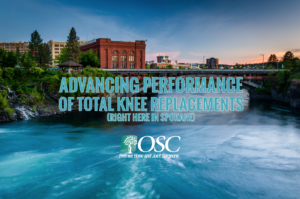 Our very own Dr. David F. Scott, a leading orthopedic surgeon and researcher, is exploring new, innovative knee implant designs and surgical techniques made for custom fit total knee replacements.
Our very own Dr. David F. Scott, a leading orthopedic surgeon and researcher, is exploring new, innovative knee implant designs and surgical techniques made for custom fit total knee replacements.
The basis for this improved knee replacement performance is an anatomical approach, whereby an implant is placed in the native joint line of a patient’s knee using specific anatomic landmarks around the knee to guide the orientation of the prosthetic components in an attempt to restore the joint to its pre-arthritic position and function. This differs from the more widely used, traditional method where total knee replacements are performed with a mechanical alignment that places implants in an average position for all patients, regardless of their individual anatomy.
Dr. Scott already employs this anatomical approach in his surgical technique, a variation on a technique known as Kinematic Alignment (KA), a surgical method made popular by Dr. Stephen Howell in 2005, and has seen the benefits it provides to his patients, including improved knee function and overall patient satisfaction.
Now, Dr. Scott is building on and advancing the work done by himself, Dr. Howell, and others by helping perfect implants specifically designed for this technique — something that has the potential to shape the future of total joint replacement procedures.
While only a small fraction of surgeons use an anatomical approach for knee replacements, the technique is gaining more interest due to exposure in scientific publications and at joint replacement meetings, symposia, and educational events, of which Dr. Scott actively participates.
Dr. Scott and Dr. Howell have worked to vocalize and teach the merits of this approach through a series of learning centers, where didactic lectures are followed by cadaver surgeries. Additionally, Dr. Scott is designing instruments to aid and perform the surgical technique, as well as advising manufacturers of orthopaedic devices on the design of research protocols to compare KA to the the traditional mechanical alignment technique with the hope of providing more concrete evidence of its merits.
“Anecdotally, the single most important finding of the research surrounding the anatomical approach is that it’s possible to improve significantly the clinical outcomes after total knee arthroplasty (TKA),” says Dr. Scott. “My research shows that an anatomic approach can work very well — that a more anatomic knee implant design, coupled with an anatomic approach to the surgical procedure itself, produces the best results ever seen with TKA.”
Although more longer-term studies are needed to prove further these already stellar results, Dr. Scott feels confident that this approach is the future of knee replacement.
“This custom alignment process is where the future of knee replacements is going. Average alignments are the old school method which I believe will be phased out completely over time,” says Dr. Scott. “The research is already out there with more being done to prove the effectiveness of custom alignments every day, and we’re really happy to be leading this work.”
Dr. Scott has published and presented research extensively in the orthopaedic field, and, specifically, on the benefits of the anatomical approach to knee replacement and implant design. He recently published a paper in the May 2018 issue of the “Journal of Arthroplasty” titled “Prospective Randomized Comparison of Posterior-Stabilized Versus Condylar-Stabilized Total Knee Arthroplasty: Final Report of a Five-Year Study”; in an ongoing study titled “Medial-Pivot, Cruciate- Substituting, Post-Market Multicenter Outcomes Study,” a multi-center study comparing the results of knees implanted with the KA approach versus the results from other surgeons using the mechanical alignment approach; and in a podium presentation titled “Patient Satisfaction and Clinical Outcomes Are Better With a Medial-Stabilized Implant vs. a Posterior-Stabilized Implant” presented to the International Society for Technology in Arthroplasty in London, England in October of 2018.
For more about Dr. Scott’s research here: orthospecialtyclinic.com/our-research.
NOTE:
This article was picked up by several news outlets recently and now Dr. Scott and Dr. Howell are working on a article together about these efforts. Stay tuned for that update soon.
